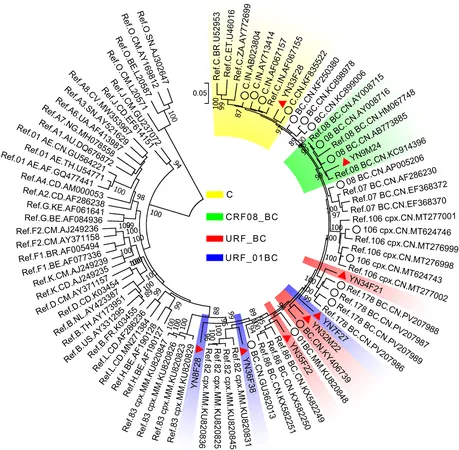
Unmasking the Evolution of HIV: A Deep Dive into Genetic Diversity in Yunnan, China
2025-07-14
Author: Ming
Understanding HIV's Genetic Landscape in Yunnan
HIV's genetic diversity is a formidable force, intricately woven through second-generation recombination events. These events shape how the virus evolves and spreads, particularly in regions like the China-Myanmar border, a known hotspot for inter-subtype recombination.
Research Insights from Baoshan, China
Recent studies from Baoshan, Yunnan Province, beckon attention as researchers investigated the genetic makeup of HIV strains among eight newly diagnosed Burmese individuals from 2006 to 2020. By constructing phylogenetic trees and employing Bootscan analysis, the research unveiled a complex web of genetic relationships.
Key Findings: A Mosaic of Subtypes and Recombinants
Among the eight HIV sequences analyzed, one was identified as subtype C and another as circulating recombinant form (CRF08_BC). Remarkably, the remaining six sequences didn't align with known subtypes, hinting at novel recombinant strains. Notably, Bootscan analysis revealed intriguing combinations of existing strains, confirming the ongoing genetic shuffle in HIV.
A Growing Challenge: The Continuing Evolution of HIV
The findings underscore the relentless evolution of HIV through recombination in this border region. The emergence of second-generation recombinants and unique recombinant forms (URFs) calls for vigilant molecular surveillance, essential for refining strategies aimed at prevention, treatment, and vaccine development.
A Global Perspective on HIV Statistics
As of the end of 2023, an astounding 39.9 million individuals live with HIV worldwide. The virus, primarily categorized into HIV-1, continues to wreak havoc globally, with group M subtypes being the chief culprits in the AIDS epidemic. Inter-subtype recombination has exponentially increased HIV's genetic diversity, complicating efforts to combat the disease.
Yunnan: A Hotbed for HIV Diversity
The China-Myanmar border serves as a critical point for understanding HIV diversity, with over 170 circulating recombinant forms (CRFs) identified, including more than 20 in this region alone. Many strains that have emerged here, like CRF07_BC and CRF08_BC, were initially identified in the early 1990s.
Research Methodology: Uncovering HIV’s Secrets
Plasma samples from newly diagnosed individuals were meticulously analyzed. Researchers extracted viral RNA and amplified near full-length HIV genomes. This technical rigor allowed for a clear picture of the genetic landscape, revealing both known and potential novel strains.
Demographic Insights from the Study Participants
The participants—eight Burmese individuals primarily comprised of uneducated farmers—showed a predominance of HIV transmission through heterosexual contacts, illustrating the socio-economic backdrop against which this research is set. Age ranged from 21 to 42 years, indicating a diverse demographic affected by this health crisis.
Concluding Thoughts: The Need for Ongoing Surveillance
The research highlights the importance of continuous monitoring of HIV genetic diversity, especially in a region as dynamic as the China-Myanmar border. As the threat of evolving strains persists, understanding these complex networks remains crucial for global public health initiatives.
Towards a Better Future in HIV Prevention and Treatment
As inter-subtype recombination continues to reshape the landscape of HIV in Yunnan, it calls for innovative strategies in treatment and prevention. With data from this study, the global community can better tackle the challenges posed by this ever-evolving virus.




 Brasil (PT)
Brasil (PT)
 Canada (EN)
Canada (EN)
 Chile (ES)
Chile (ES)
 Česko (CS)
Česko (CS)
 대한민국 (KO)
대한민국 (KO)
 España (ES)
España (ES)
 France (FR)
France (FR)
 Hong Kong (EN)
Hong Kong (EN)
 Italia (IT)
Italia (IT)
 日本 (JA)
日本 (JA)
 Magyarország (HU)
Magyarország (HU)
 Norge (NO)
Norge (NO)
 Polska (PL)
Polska (PL)
 Schweiz (DE)
Schweiz (DE)
 Singapore (EN)
Singapore (EN)
 Sverige (SV)
Sverige (SV)
 Suomi (FI)
Suomi (FI)
 Türkiye (TR)
Türkiye (TR)
 الإمارات العربية المتحدة (AR)
الإمارات العربية المتحدة (AR)